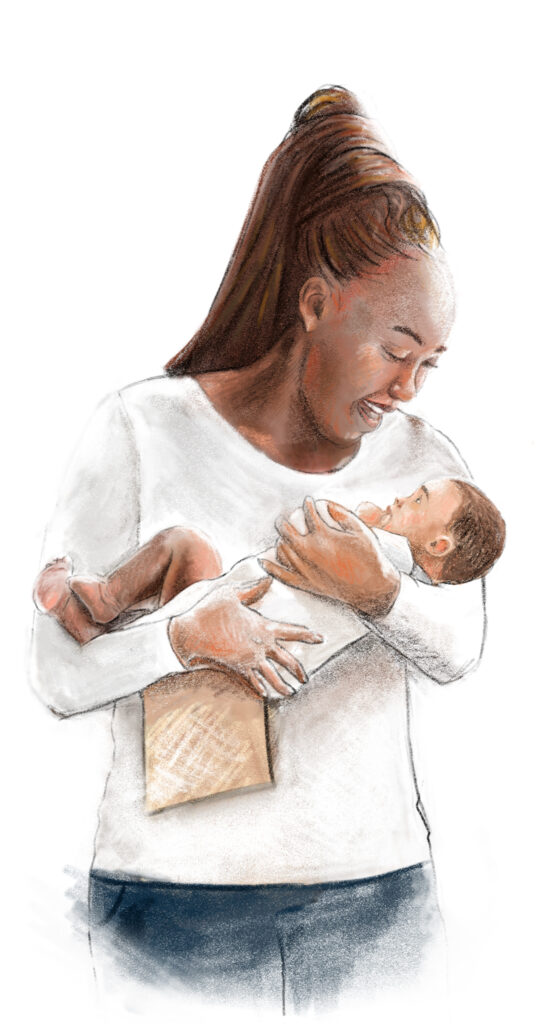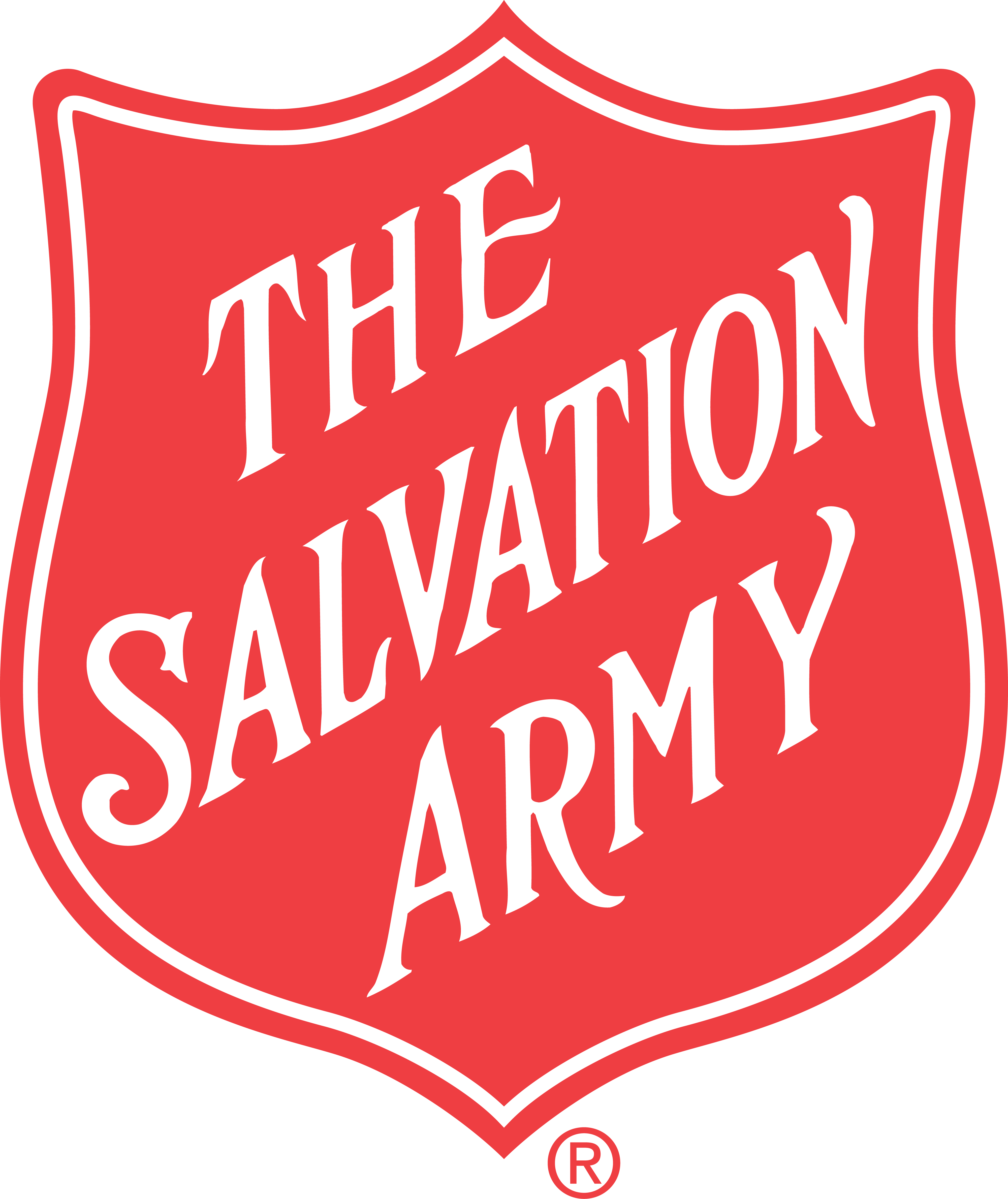Fostering God’s Children
by Warren L. Maye

illustrations by Joe Marino
In Pennsylvania alone, as many as 3,000 young people live in foster care holding centers designed for 48-hour stays. Now more than ever, families are needed nationwide to provide hundreds of thousands of children with loving foster homes, and maybe even adoption.
“I prayed for this child, and the Lord has granted me what I asked of him.”
—1 SAMUEL 1:27
“Do you want me to be your mom?”
What a strange question to ask of a malnourished 7-month-old infant. But Grace Burke, an experienced nurse who had delivered more than 4,000 babies in her career as a midwife, looked deep into the child’s eyes, held her close, and believed she would answer.
“I could tell I was making eye contact,” said Burke in an interview with SAconnects. “I could tell she understood what I was saying.” The little girl’s innocent gaze created a bridge of understanding that went far deeper than mere words. Grace remembers, “She fell asleep in my arms, and we never looked back.”
The child, known only as “Baby” because her birth records were sealed, had been in the home of an elderly couple on Long Island, N.Y. In need of the extra cash foster care provided, they were willing to temporarily house the child. They would put Baby to bed at 6 p.m., then never look at her again until morning.
“I was handed a brown paper bag that had a half-drunk bottle of milk and a Pamper. Nothing else. No clothing, no diapers, no toys. Nothing. They said, ‘Here’s your baby.’”
Still, receiving Baby was a dream come true for Burke. She’d gotten the devastating news from her doctor that, following an unplanned hysterectomy, she and her husband would never have children of their own. As she grieved the loss, she also stopped delivering babies. “It was just too hard to be involved in other couples’ birthing experiences when I, myself, had not healed,” she writes in her memoir Broken Pieces: Mending the Fragments Through Adoption (see book review).
Regardless of the circumstances, Burke was elated to have Baby. She celebrated during a shopping spree with her friend Hazel. “We went downtown and just went crazy, buying all the baby clothes and the girly clothes and the shoes—everything that child needed,” she recalls. “She had her own room. You know, it’s like she went from darkness to light. But she was very traumatized.” Burke observed signs of apparent physical and emotional neglect, as well as the impact that Baby’s birth mother’s substance misuse might have had on the child’s mind and body even before she was born.
A vital need for foster families
“Emotional tsunamis over a small disappointment, or a simple request; rage that erupts out of nowhere,” says the narrator of a video on how children react to trauma. “What triggers a teenager to regress to thumb-sucking? Or a sudden emotional shutdown?” In the video, “TBRI® An Overview: Putting the Pieces Together,” such questions are answered in depth with real-life scenarios. It’s one of many resources available via The Salvation Army Eastern Pennsylvania Children’s Services website.
Trauma can result from painful or frightening experiences. The memories, bathed in vivid imagination, can keep children in survival mode as they dwell over what happened and the worst of what could have happened.
“He will turn the hearts of the parents to their children, and the hearts of the children to their parents.”
–MALACHI 4:6

Angie Gillen, a certified Trust-Based Relational Intervention (TBRI) practitioner and director of education and outreach for The Salvation Army in Allentown, Pa., knows all about how and why these children view their present and future through the lens of a terrifying past. She has seen vulnerable and fragile children cower, scream, or fight when playtime is over, or when their orange juice is finished.
Gillen works to raise awareness in the community about the need for foster and adoptive families to help give kids a better life. She told SAconnects that the lack of enough homes for foster care and adoption is at a crisis level.
“In Pennsylvania, there are almost 3,000 kids waiting for adoption,” says Gillen, “but I suspect the problem is nationwide. There’s always been a bottleneck. There’s also been a challenge in finding homes for older kids, and larger sibling groups, and kids with more significant special needs.” Indeed, more than 360,000 children are currently in need of homes according to the Children’s Bureau (U.S. Department of Health and Human Services; see sidebar).
People who might be willing to consider adding more kids to their home are often hesitant because many of the children have experienced trauma such as abandonment or forms of emotional, mental, physical, or sexual abuse. But they should know that there are support systems in place, some of which are covered in the next section.
“People don’t know that there’s a desperate need for foster families. Agencies who are nonprofits and have small operating budgets can’t shoulder the burden of making the entire community aware,” Gillen says. “Kids are usually placed in foster care within the county that they originate from. We’re in Lehigh County and Montgomery County. We serve other counties around there, but we’re getting calls from the other side of the state.”
Gillen remembers one such caller. “I asked her, ‘Do you realize where Lehigh County is?’ She said, ‘Yep, and I called every agency between us and you, and no one has a place now.’”
The opioid crisis is a large contributor to the problem.
“Drugs are just prolific,” Gillen says, “and people struggle with not enough money, support, or resources. They are using drugs and alcohol to self-medicate their mental health challenges. That leads to more kids coming into care. Drug and alcohol misuse is the No. 1 reason kids come into care.”
Seeing through a foster parent’s eyes
The good news is, there are families and individuals who are stepping up to the challenge and opening their doors and hearts to these young people. For more than 20 years, Angela Russell, a single mother of one biological daughter and a graduate of Hunter College in New York City, has served as a certified foster care mother there. Her reputation for offering exemplary care to children and effective recruitment of new foster care families caught the attention of ABC7 Eyewitness News, which featured her in a 2023 special report, “Protect Our Children: Surviving the System.”
“One of the ladies called me and said, ‘Hey, ABC’s running a special on foster care and contacted our agency, and we contacted some kids, and one of your girls was really speaking so highly about you,’” remembers Russell in an interview with SAconnects. “ABC came with the cameras and turned my house into a studio.” But Russell, who was inspired by her own parents’ willingness to share their home with children in need, wanted the focus not on her but on the people benefiting from the work.
“Being a foster parent has enriched my life so much. I wanted to help out those who were less fortunate in the community, and I saw the need for it. You get to change a person’s life,” Russell told ABC. “When I was growing up, it was mom, dad, brothers and sisters, and other children who just became a part of the family. My mom and dad served as a great example of how I could become a foster parent.
“It is not easy being a foster parent. It’s challenging. Some of the kids have never had a good hug, never had anyone to compliment them. I’ve learned over the years, trying to see things through their lens, learn to build on their strengths. They come in. They are beautiful, broken children,” Russell said during the broadcast. “See the good in them.”
Russell told SAconnects that a flawed system can add to the trauma these young people experience. High turnover of the social workers is a problem.
“Children who have suffered losses shouldn’t have people coming in and out of their lives like that,” Russell says. “If you’ve lost a mom or dad or you’re displaced from your home, and you have one caseworker every week—most times it’s a person from college, they’re not invested into the job—by the time they know the child, they’re gone. Then another person comes. So those are some things that affect the child, and that’s where the trauma can happen. They’re already displaced. They’re already disappointed. Everyone’s disappointed them.”
But Russell is quick to point out that many services and tools are available to assist young people in foster care with educational, emotional, and physical help along their journey to wholeness. “Each of them has a case planner on the team, and they all go to a doctor or clinic. Their records are kept in one place, and they get everything they need. These are not kids who are thrown to the wolves. They get their dental and their glasses. If they manage to go to high school and go to college, they get computers to books to—everything.”
In New York City, for example, the Fostering College Success Initiative (formerly the Dorm Project) helps students in foster care live in dorms and receive life coaching, tutoring, and career counseling. There are also resources for young people who are transitioning from foster care to independent living.
Russell urges foster children to take full advantage of all the programs offered. “Use the therapist, use everything,” she tells them.
“Because once they reach 18 and get housing, once that happens, they’re no longer in care. Then they get a job. They must pay some rent. As soon as they get a better job, their portion of the rent increases. Some of them don’t do better because they’ve never taken advantage of the resources. If they’re in college, they can be in a home.”

Success stories
Good outcomes are possible through foster care. It can lead to successful adoptions. For instance, Colonel Wendy Laxton Morris is currently the president of women’s ministries for The Salvation Army’s Japan Territory. But her life began as a newborn in foster care. She was adopted through The Salvation Army’s adoption agency in New York City and went on to enjoy a blessed family life.
“My parents emigrated from England to the United States in the ’50s. They could not have children of their own. The Army was starting up their work with adoption and foster care in New York,” Wendy says. “My parents were Salvationists. So, they thought, ‘Let’s just go with what we know.’ They went through the processes of having social services visit their home, all that sort of thing.
“They waited quite some time. My mother used to say, ‘It’s women who are only pregnant nine months who don’t understand what it means to wait sometimes eight years to have a baby.’
“But eventually it worked. I was born August of 1965 in Manhattan and brought home in February of 1966.”
Back in those days, the agency kept children until it knew for sure that they were healthy. Wendy was in the foster care system in New York City and doesn’t know where she lived those first six or seven months of her life.
Two years later, her parents also adopted Judy, who was born at Booth Memorial Hospital in Jamaica in Queens, N.Y. The family moved from Jamaica to Long Island, where Wendy grew up attending The Salvation Army in Hempstead. She went to Asbury College and met her husband there.
“We were called to officership, and that’s how I ended up in the Southern Territory, where he is from,” Wendy says.
“We had a wonderful upbringing. My parents were very clear from the time we were young girls that we were ‘hand-picked and specially chosen.’ My parents couldn’t have children of their own, but God provided something incredible by allowing them to adopt a baby. There was a baby out there that needed them as much as they needed her. My sister and I were brought up to understand that this was a very positive experience. As a child, I thought, ‘Well, they must have picked me out of a big bunch of babies.’”
“A father of the fatherless, a defender of widows, is God in His holy habitation. God sets the solitary in families; He brings out those who are bound into prosperity.”
–PSALM 68:5-6 (NKJV)
Not everyone shared the family’s vision of adoption. “I must have been about 8 or 9, at the corps, and in Junior Soldier class with my sister and another kid. He whispered to the other kids, ‘Did you know that the Laxton girls were adopted?’” Wendy recalls.
“I remember running to my mother and asking, ‘What’s wrong with us being adopted?’ Obviously, somebody’s family had been talking about this at home. That was one of those turning points where I thought, ‘OK, so not everybody thinks this is great.’”
When Wendy was 13 or 14, a time when teenagers go through all the angst of being different, she remembers thinking: If my parents really wanted me, then somebody didn’t. I was not chosen by one family for another family to choose me. She had to work through the idea that she’d been given up.
Her sister, Judy Davenport, is also a Salvationist and a member of the Tustin Ranch Corps in California. Today, changes in the law have allowed Wendy and Judy to access their birth records. Modern DNA technology has also made it possible for them to find and reunite with their birth mothers. They now enjoy relationships with them and their families.
Challenges and rewards
Besides Baby, Grace Burke’s 42 years of experience with the foster care system includes two more adopted children who’ve since grown to become biological parents themselves. Years after adopting her children, Burke became the full-time foster mom for her twin grandchildren when their parents were temporarily unable to care for them.
“It was a wonderful time of blessing for my husband and me as well as for the children,” she says. “Five years later, they returned to their parents and are now healthy, thriving young adults.”
Burke, who earned a doctorate in theology, ministers to other families seeking guidance. “I want parents to know that every child has a history file somewhere,” she says. “There are a lot of reasons why they are placed for adoption. Most of the time, the [biological] parent has made the decision that they cannot look after the child for whatever reason. They are trusting they’ll fall into the right hands. But that doesn’t always happen. Sometimes they get left in group homes until they age out. Unfortunately, they never find an adoptive home. Or they find an adoptive home that’s below par—they really don’t look after the children, they’re doing it for the money.”
Burke points out some important considerations for those thinking of becoming foster or adoptive parents. For one, the biological parents may want to see the baby periodically, or to get pictures or reports on how the child is doing. “The adoptive family must decide, ‘OK, I can live with an open adoption. Or, you know, I really don’t want the influence of the prior family to make a difference in what I do.”
Sometimes, Burke says, the biological family may search for the child later. They may just want a relationship—but they may even want the baby back. She says potential adoptive parents must ask themselves: “Am I going to be OK with another family claiming responsibility for my child who I adopted, who now has my name?”
Burke says, “When the child gets older, they may want to find the biological family. They may say, ‘I have nothing against my adoptive parents. I love them to death. But I want to know, who are the people who caused me to be in this world? Who gave birth to me? What do they look like? Who are they?’
“How am I going to feel when they connect, if they do? Am I going to help them, or am I going to say, ‘Well, that’s up to you.’”
Is it all worth it?
With so many potential complications, Gillen says, the most important question families should ask but typically don’t is: Does caring for this child, who’s been through so much, really make a difference?
Gillen’s voice seems to rise from deep within her soul when she says, “The answer to that is ‘Yes, it makes an incredible difference. Incredible.’
“Sometimes, foster families only have children for a very short time in their home. Maybe they’re reunified, or they go to a relative. But the fact that they kept them safe and gave them love and security—the impact on those kids is enormous, enormous. It can set them on a trajectory for a completely different future.”
From a purely biblical perspective, we see how Moses was adopted by the pharaoh’s daughter and became the leader of his people (Exodus 2:1–10; 3). Esther was adopted by her cousin and became a queen who helped save her people from annihilation (the Book of Esther). Jesus was adopted by His earthly father, Joseph, and became the spiritual Savior of the entire world (New Testament). Foster care and adoption can—and they do—make a difference.

